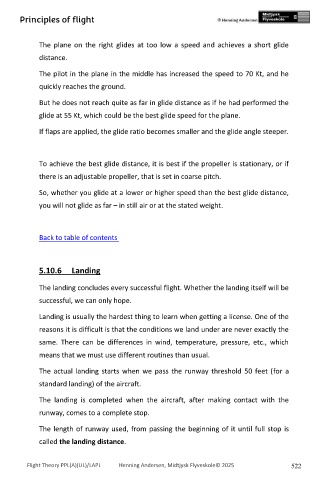Page 522 - PPL-engelsk 2025
P. 522
Principles of flight
The plane on the right glides at too low a speed and achieves a short glide
distance.
The pilot in the plane in the middle has increased the speed to 70 Kt, and he
quickly reaches the ground.
But he does not reach quite as far in glide distance as if he had performed the
glide at 55 Kt, which could be the best glide speed for the plane.
If flaps are applied, the glide ratio becomes smaller and the glide angle steeper.
To achieve the best glide distance, it is best if the propeller is stationary, or if
there is an adjustable propeller, that is set in coarse pitch.
So, whether you glide at a lower or higher speed than the best glide distance,
you will not glide as far – in still air or at the stated weight.
Back to table of contents
5.10.6 Landing
The landing concludes every successful flight. Whether the landing itself will be
successful, we can only hope.
Landing is usually the hardest thing to learn when getting a license. One of the
reasons it is difficult is that the conditions we land under are never exactly the
same. There can be differences in wind, temperature, pressure, etc., which
means that we must use different routines than usual.
The actual landing starts when we pass the runway threshold 50 feet (for a
standard landing) of the aircraft.
The landing is completed when the aircraft, after making contact with the
runway, comes to a complete stop.
The length of runway used, from passing the beginning of it until full stop is
called the landing distance.
Flight Theory PPL(A)(UL)/LAPL Henning Andersen, Midtjysk Flyveskole© 2025 522

